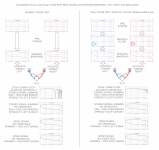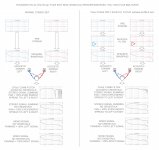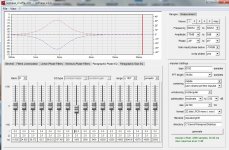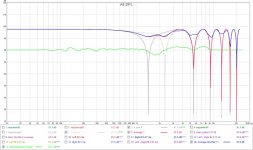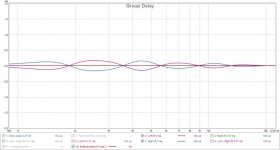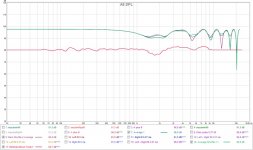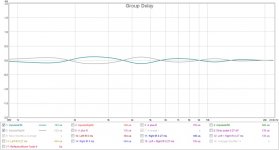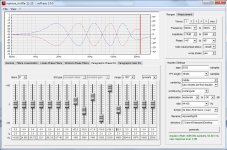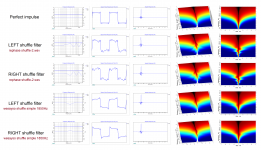I think you need to look again Bob, no offence...
If you look at this plot:

Pay close attention to the lowest green trace. That's an actual measurement taken at a dummy head from a phantom center signal. I believe this was the plot taken in a reflective room though. Do you see dips and peaks that relate to the Dirac combing curve? That is because they were influenced by that Dirac combing curve I show. Now look at the magnitude of the peaks and dips in the Dirac curve by itself. That is a presentation of a 100% SPL IR at 0 ms (original wave front) plus a 100% IR representing the leak, or better worded as cross talk arriving delayed 0.270 ms at the ear.
The real world result is nowhere near as severe as this. Again, imagine a straight line FR (first wave) and now subtract the Dirac comb plot (but scaled due to various reasons among which is head shading) gets you the curve as measured by Toole.
Now imagine doing the same but with the shuffler curve creating that difference. Which one will be more benign.
There is more than a good chance here the actual result as measured at the ear(1) is going to be closer to the FR we started with than without using the shuffler. The dip at 2 KHz will be less deep. The peaks at 3.7 and 7.4 KHz will not stand out as much anymore, as they are less prominent.(*)
But it's never reaching the big difference of 6dB+ magnitude you are talking about. We are actually trying to reduce any ripple from the combing. And I can tell you I do believe it works. As there is a better tonality in the center vocal, one I could never quite EQ in. Its sounding like the sides actually, short of some balancing I need to redo. It clears up the center. It does not color it.
I would not want to spread anything though. Not sure what you mean by that. The whole trick of stereo is to have a seamless stage without any queue to the speakers. Signals the cross the stage, like a tambourine from right to left is much more realistic for me.
Don't mistake my plots for being true to the real comb filter levels. Again, compare Toole's plot, that Dirac comb result caused that one. It won't be until we cam measure this in a good room and a dummy head until I could actually convince you, but we are only filling dips.
Technically, the phase shuffler should be without the turn at ~3700 KHz. As dynomike has assumed and I have to agree. But that extra swing only creates a negligible dip in the curve and makes sure the shifting of the dips works as intended. I've done with and without. I like it more with for now.
Have you ever experienced a phantom center that was a bit dull sounding compared to the sides (or the sides brighter than the center) with a 60 degree stereo setup in a well treated room (meaning absence of early reflections at least)?
All that phase talk isn't of any other purpose than to shift the dips. We are not using the phase manipulation to fool your brain, we let the resulting frequency magnitude do that. That's the real purpose of shifting the dips.
(*)= keep in mind we do need our two ears for this. As the dips are still there, only shifted up or down in frequency, resulting in a better overall result your head gets to process.
(1)= But we have to take a look at the sums at both ears to find it. Because the shuffler only moves dips, it does not solve them. Our own processor is the one that has to do the hard work to reconnect what it hears. The measurements will most probably still find dips. But now in different positions left and right. The shuffler is a fitting name!
I hope this helps you see what's going on. The graphs I show here are never a representative of the frequency response at the ear. You only need to compare which plot you'd rather have eating away on your perfectly balanced straight line FR. I know which one I'm picking. And to think that I'm a phase coherency freak 😀. And now I'm knowingly and willingly introducing phase swings!
== private note to Bob, this is what I meant by me rambling on. If I do that I usually retreat to my own thread 😉 ==
If you look at this plot:

Pay close attention to the lowest green trace. That's an actual measurement taken at a dummy head from a phantom center signal. I believe this was the plot taken in a reflective room though. Do you see dips and peaks that relate to the Dirac combing curve? That is because they were influenced by that Dirac combing curve I show. Now look at the magnitude of the peaks and dips in the Dirac curve by itself. That is a presentation of a 100% SPL IR at 0 ms (original wave front) plus a 100% IR representing the leak, or better worded as cross talk arriving delayed 0.270 ms at the ear.
The real world result is nowhere near as severe as this. Again, imagine a straight line FR (first wave) and now subtract the Dirac comb plot (but scaled due to various reasons among which is head shading) gets you the curve as measured by Toole.
Now imagine doing the same but with the shuffler curve creating that difference. Which one will be more benign.
There is more than a good chance here the actual result as measured at the ear(1) is going to be closer to the FR we started with than without using the shuffler. The dip at 2 KHz will be less deep. The peaks at 3.7 and 7.4 KHz will not stand out as much anymore, as they are less prominent.(*)
But it's never reaching the big difference of 6dB+ magnitude you are talking about. We are actually trying to reduce any ripple from the combing. And I can tell you I do believe it works. As there is a better tonality in the center vocal, one I could never quite EQ in. Its sounding like the sides actually, short of some balancing I need to redo. It clears up the center. It does not color it.
I would not want to spread anything though. Not sure what you mean by that. The whole trick of stereo is to have a seamless stage without any queue to the speakers. Signals the cross the stage, like a tambourine from right to left is much more realistic for me.
Don't mistake my plots for being true to the real comb filter levels. Again, compare Toole's plot, that Dirac comb result caused that one. It won't be until we cam measure this in a good room and a dummy head until I could actually convince you, but we are only filling dips.
Technically, the phase shuffler should be without the turn at ~3700 KHz. As dynomike has assumed and I have to agree. But that extra swing only creates a negligible dip in the curve and makes sure the shifting of the dips works as intended. I've done with and without. I like it more with for now.
Have you ever experienced a phantom center that was a bit dull sounding compared to the sides (or the sides brighter than the center) with a 60 degree stereo setup in a well treated room (meaning absence of early reflections at least)?
All that phase talk isn't of any other purpose than to shift the dips. We are not using the phase manipulation to fool your brain, we let the resulting frequency magnitude do that. That's the real purpose of shifting the dips.
(*)= keep in mind we do need our two ears for this. As the dips are still there, only shifted up or down in frequency, resulting in a better overall result your head gets to process.
(1)= But we have to take a look at the sums at both ears to find it. Because the shuffler only moves dips, it does not solve them. Our own processor is the one that has to do the hard work to reconnect what it hears. The measurements will most probably still find dips. But now in different positions left and right. The shuffler is a fitting name!
I hope this helps you see what's going on. The graphs I show here are never a representative of the frequency response at the ear. You only need to compare which plot you'd rather have eating away on your perfectly balanced straight line FR. I know which one I'm picking. And to think that I'm a phase coherency freak 😀. And now I'm knowingly and willingly introducing phase swings!
== private note to Bob, this is what I meant by me rambling on. If I do that I usually retreat to my own thread 😉 ==
Last edited:
Someone mentioned one can use sox to convolve two impulses? Does anyone know what the commands are?
Wesayso, you presented another method using JRiver. What did you mean when you said you put blank space in the early part of the impulse and how did you do it?
Wesayso, you presented another method using JRiver. What did you mean when you said you put blank space in the early part of the impulse and how did you do it?
I opened the stereo impulse in a wave editor and inserted silence to the beginning and at the end of that impulse. In my experience the wave recorder in JRiver can cut some of it off when using convolution. I use the original impulse as a reference to get the length of the JRiver recorded impulse right again after convolving it with the disk writer mechanism. Making sure the peak is in the exact same position as before, especially important if you run more than one convolution chain as I have one stereo IR for the mains and one for my ambient channels, with a text file routing the signals.
I confirm these steps by reading them with REW, making sure it all went according to plan.
Happy to see you thinking of trying this out! At least I hope you are...
I confirm these steps by reading them with REW, making sure it all went according to plan.
Happy to see you thinking of trying this out! At least I hope you are...
Last edited:
Fun from REW (based latest info what we think can happen) and this time model speaker with IRR system stopbands, picture 1 and 2 is same only resolution is difference, 1 is 50% scaled down version, 2 is full resolution if wish is study small numbers in plots.
Attachments
Thanks much for helping me understand this. I guess I'm not up to speed on the latest digital processing technology. Does the shuffler phase shift one channel relative to the other, by approx. 60 degrees, at all frequencies? Thereby allowing the brain to convolve and perceive a less colored center image? Am I getting that right?
I'm a bit of a rambler too. It's hard to try and explain electronics, speakers or acoustics without going on and on... 😀 This is complicated stuff.
I'm a bit of a rambler too. It's hard to try and explain electronics, speakers or acoustics without going on and on... 😀 This is complicated stuff.
This phase plot shows the phase swings and at which frequencies, as does BYRTT's example:

Hope this helps, no change to the FR curve.

Hope this helps, no change to the FR curve.
I opened the stereo impulse in a wave editor and inserted silence to the beginning and at the end of that impulse. In my experience the wave recorder in JRiver can cut some of it off when using convolution. I use the original impulse as a reference to get the length of the JRiver recorded impulse right again after convolving it with the disk writer mechanism. Making sure the peak is in the exact same position as before, especially important if you run more than one convolution chain as I have one stereo IR for the mains and one for my ambient channels, with a text file routing the signals.
I confirm these steps by reading them with REW, making sure it all went according to plan.
Happy to see you thinking of trying this out! At least I hope you are...
Thanks! Yes, of course I am interested. Pano had sent me a shuffler file almost a year or two ago before my line arrays. But at the time I did not like it much because it caused weird things to happen like sound sticking to the speakers. But it seems Pano has made some improvements after his original trial.
Have you guys tried fixing just the main 1.7 kHz dip and leaving everything else alone? Seems like that is the most prominent one. Is there a file that shuffles the phase at only 1.7 kHz?
I know dynomike has tried one with only a shuffle at ~1.7 KHz. Easy enough to try too.
But don't concentrate on the Toole graph alone, as that one was made in a reflective room.
But don't concentrate on the Toole graph alone, as that one was made in a reflective room.
Here you go, one shuffle at 1850:

Compared to my other one, published a few posts back:

Have fun! See attachment...
Compared to my other one, published a few posts back:
Have fun! See attachment...
Attachments
Last edited:
Perfection! Thanks Wesayso!
Didn't Toole also say that head shadowing becomes less of a problem with higher frequencies? It might have something to do with the ray-like behavior of waves of higher frequencies. In other words, the wave just bounces off the head and doesn't really register on the other ear. At what frequency does it stop? Who knows. But would be good to test that. I'm just coming from the principle of doing as little harm as possible, even if the only thing we are doing is flipping the phase by a few degrees.
Didn't Toole also say that head shadowing becomes less of a problem with higher frequencies? It might have something to do with the ray-like behavior of waves of higher frequencies. In other words, the wave just bounces off the head and doesn't really register on the other ear. At what frequency does it stop? Who knows. But would be good to test that. I'm just coming from the principle of doing as little harm as possible, even if the only thing we are doing is flipping the phase by a few degrees.
Last edited:
Shuffling phase at higher frequencies should be even less of a time penalty.
I did try a shuffler with less rotations, omitting the one at 3700 Hz. In the end I liked Pano's Shuffler-2 better and my own Shuffler 11.
Here's the group delay over the shuffled area of interest:

Though I agree with you, in trying to create the least amount of harm to the signal.
Just convolve a couple of songs offline, using one or multi shuffles, and throw in some original tracks. Let JRiver take care of the play back SPL and shuffle the songs. I bet you'll be able to pick your favorite choice that way. Though it's often hard not to let a change in tonal balance influence you there should be some stage perceptual differences that will sway you. Or not! 🙂
I did try a shuffler with less rotations, omitting the one at 3700 Hz. In the end I liked Pano's Shuffler-2 better and my own Shuffler 11.
Here's the group delay over the shuffled area of interest:
Though I agree with you, in trying to create the least amount of harm to the signal.
Just convolve a couple of songs offline, using one or multi shuffles, and throw in some original tracks. Let JRiver take care of the play back SPL and shuffle the songs. I bet you'll be able to pick your favorite choice that way. Though it's often hard not to let a change in tonal balance influence you there should be some stage perceptual differences that will sway you. Or not! 🙂
Attachments
Last edited:
We still haven't fully explored less phase rotation. Here's one that swings ~27 degree @ 1850. About 1.5 dB difference at that 1850 Hz point in this 100% subtraction plot:

Real life the difference should be far less. Look how deep a Dirac pulse dip is.
The group delay plot gives less time deviation. (123 us instead of 148 us for Pano's and 164 us for my Shuffler11)

Rephase view:

Looks like a pretty good trade to me. Could be a good way to go.
Real life the difference should be far less. Look how deep a Dirac pulse dip is.
The group delay plot gives less time deviation. (123 us instead of 148 us for Pano's and 164 us for my Shuffler11)
Rephase view:
Looks like a pretty good trade to me. Could be a good way to go.
Attachments
Last edited:
Maybe I'm coming to this much too late, but wouldn't it be useful to have a physical Center speaker, but operating at a low enough level that all it does is prevent deep cancellation nulls? This would address the center-tonality problem without significantly affecting the overall soundstage.
Alternatively, the phase shuffling could be applied to the Center speaker (again, at a reduced level compared to L and R) while leaving L and R unprocessed. The idea is to improve tonality (and stability) of the central image while not degrading overall spatial qualities of the recording.
My concern about intentional phase shifts applied between L and R channels is image blurring, and subtle changes in timbre that might occur when close-to-center phantom images are spread out spatially.
Alternatively, the phase shuffling could be applied to the Center speaker (again, at a reduced level compared to L and R) while leaving L and R unprocessed. The idea is to improve tonality (and stability) of the central image while not degrading overall spatial qualities of the recording.
My concern about intentional phase shifts applied between L and R channels is image blurring, and subtle changes in timbre that might occur when close-to-center phantom images are spread out spatially.
Hello Lynn,
I cannot say this phase shuffling has degraded my imaging, quite the opposite in fact. If you can play a CD try and burn a couple of these test tracks below and you can try it yourself. Of these two variants I liked Pano's shuffler best. But it's easy to compare the unprocessed tracks (fragments really) with Pano's phase shuffler to get an idea what this does for our perception.
I was skeptical but curious enough to try, having spend quite some time to get my phase and FR left and right to match. But after a listening test of a couple of songs I know very well I was quite (positively) surprised with what I heard. I did not expect this.
I cannot say this phase shuffling has degraded my imaging, quite the opposite in fact. If you can play a CD try and burn a couple of these test tracks below and you can try it yourself. Of these two variants I liked Pano's shuffler best. But it's easy to compare the unprocessed tracks (fragments really) with Pano's phase shuffler to get an idea what this does for our perception.
I was skeptical but curious enough to try, having spend quite some time to get my phase and FR left and right to match. But after a listening test of a couple of songs I know very well I was quite (positively) surprised with what I heard. I did not expect this.
https://www.dropbox.com/sh/p2eww8mm4kxl4rf/AABwdEsCWT19nk6e5jfl8o2La?dl=0
Clips in "Original" (unprocessed), "Pano Rephase-2", and "Mike Min9".
Jane - Ben Folds Five
Our Prayer - Beach Boys (original mono)
Impossible Spaces - Sandro Perri
Limit to Your Love - James Blake
Black Skinhead - Kanye West
River Deep, Mountain High - Tina Turner (original mono)
Drume Negrita - Ry Cooder and Manuel Galban
De Camino a La Vereda - Buena Vista Social Club
Bang Bang - Nancy Sinatra (original *almost* dual mono)
Surf's Up (solo piano version) - Brian Wilson
Can't Feel My Face - The Weeknd
Angel - Sarah McLaughlin
A Movie Script Ending - Death Cab for Cutie
Clips are the same volume although peak levels are different due to the phase shuffling.
Hi Lynn, good to see you here.
Yes, one could use a center speaker to overcome the problem, but then you don't have a phantom center anymore. Who you gonna call? Ghostbusters! 😀 But I understand using the center just as a slight fill. It might not need to be full bandwidth, 1000-8000Hz would probably do. The main tonality change is around 2K
On my Altec multi-cell system the shuffler did make much difference to the image, at least not very noticeable. The main difference if that the sides and center now sound the same. Yes, that is going to change tonality, but that's the point. I found it made the system overall too bright, because I had EQ'd it with a dull center. Once the center was as bright as the sides, the overall system balance needed to come down a bit.
Yes, one could use a center speaker to overcome the problem, but then you don't have a phantom center anymore. Who you gonna call? Ghostbusters! 😀 But I understand using the center just as a slight fill. It might not need to be full bandwidth, 1000-8000Hz would probably do. The main tonality change is around 2K
On my Altec multi-cell system the shuffler did make much difference to the image, at least not very noticeable. The main difference if that the sides and center now sound the same. Yes, that is going to change tonality, but that's the point. I found it made the system overall too bright, because I had EQ'd it with a dull center. Once the center was as bright as the sides, the overall system balance needed to come down a bit.
Perfection! Thanks Wesayso!
Didn't Toole also say that head shadowing becomes less of a problem with higher frequencies? It might have something to do with the ray-like behavior of waves of higher frequencies. In other words, the wave just bounces off the head and doesn't really register on the other ear. At what frequency does it stop? Who knows. But would be good to test that. I'm just coming from the principle of doing as little harm as possible, even if the only thing we are doing is flipping the phase by a few degrees.
Other thing that think can influence shuffler to be less of a problem at higher frq is speakers relative low bandwidth compared upstream device performce, HF transients influenced a phase turn already at -90º for a textbook tweeter with 20kHz BW2 roll off, where some amps reproduce fine square waves >100kHz area (zobel filter temporary disabled) speakers fade out in 5-6kHz area even B&W try hard with diamonds : )
Even below examples is turning phase inside audio band window 20Hz-20kHz, we may hope for future tweeters can improve higher reach and maybe roll off a smoother BW1 verse BW2.
HF BW2 stopbands red=100kHz blue=500kHz:
Should you wish create other sample rate than 44,1kHz settings file for "rephrase shuffle-2.wav" filter from Pano available at post 247.
Below is timing graphs to compare perfect impulse verse rephrase shuffle-2 filter and the light 1850Hz version wesayso shared post 269.
Attachments
Further to my idea of Post # 356 i experimented on the song, Hang on to your love by Sade, with the following.
I converted the song into mono, & then imported it into a multitrack audio editor etc on Track 1. Then imported the original stereo song onto Tracks 3 & 4 as well. Then i moved the mono Track 64th of a bar behind the stereo one to delay it slightly. I also reduced the level of it by 6db & added a few db of hf EQ & lowered the lf EQ by a few db. When i say a few, that's because i tinkered with various settings & can't remember exactly what they were ! Anyway, i'm sure you'll find the sweetspot somewhere 😉
The delay could be even shorter, along with altering the mono level & EQ's. Try it & see what you think. Interestingly, so far the stereo image doesn't appear to suffer 😀
@ Pano
I hadn't realised you had already suggested what you did 😉
To everybody involved in this, congrats on what you've acheived so far 🙂
I converted the song into mono, & then imported it into a multitrack audio editor etc on Track 1. Then imported the original stereo song onto Tracks 3 & 4 as well. Then i moved the mono Track 64th of a bar behind the stereo one to delay it slightly. I also reduced the level of it by 6db & added a few db of hf EQ & lowered the lf EQ by a few db. When i say a few, that's because i tinkered with various settings & can't remember exactly what they were ! Anyway, i'm sure you'll find the sweetspot somewhere 😉
The delay could be even shorter, along with altering the mono level & EQ's. Try it & see what you think. Interestingly, so far the stereo image doesn't appear to suffer 😀
@ Pano
I hadn't realised you had already suggested what you did 😉
To everybody involved in this, congrats on what you've acheived so far 🙂
@ Pano
Well it all depends on the mono level & eq settings. That's why i'm hoping others can try it & discover their findings etc too. But with the short time i've had experimenting, i found the tone could be made to sound quite natural & blend in nicely. Early days 😉
I did find that anything more that a 64th started to give a flange effect, which obviously isn't wanted.
Well it all depends on the mono level & eq settings. That's why i'm hoping others can try it & discover their findings etc too. But with the short time i've had experimenting, i found the tone could be made to sound quite natural & blend in nicely. Early days 😉
I did find that anything more that a 64th started to give a flange effect, which obviously isn't wanted.
- Home
- Loudspeakers
- Multi-Way
- Fixing the Stereo Phantom Center
